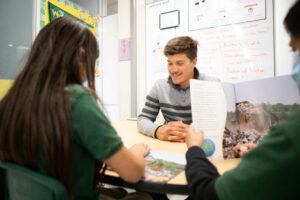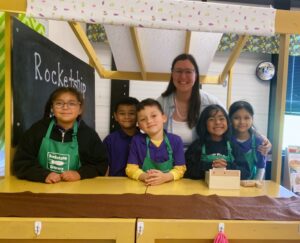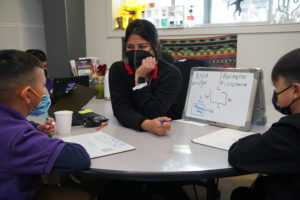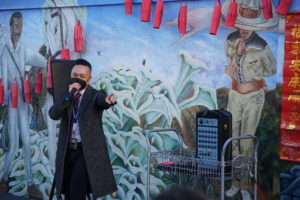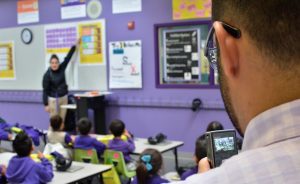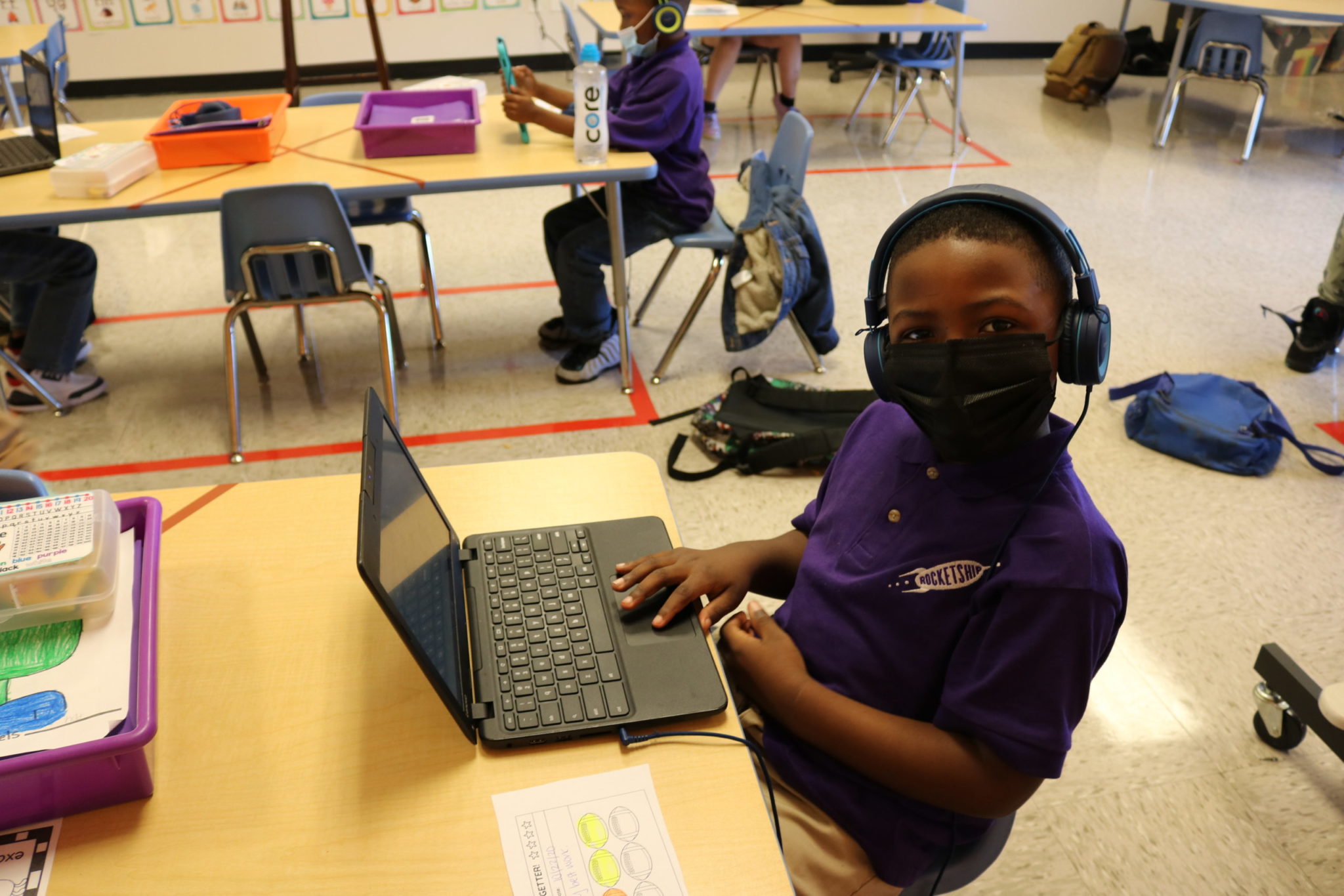
Our Schools in Nashville Transitioned Back into the Classroom. Here’s How the First Two Weeks Went.
By James Cross, 4th Grade Teacher, Rocketship Nashville Northeast Elementary
My ground-floor one-bedroom apartment was never meant to be the home of an elementary school classroom. My 600 square foot apartment doesn’t even have a desk or a table to teach from. When we first went virtual, I bought a matte black patio chair that best aligned to my mid-century modern living room aesthetic and used the back of my couch as a surface to set my computer on. This wasn’t ideal, but I quickly learned that a classroom, however, doesn’t ascribe to a binary, a classroom exists on a spectrum.
Virtual teaching was stressful, new, frustrating, beautiful, and a burden that will plague us for years to come. My students learned though. Contrary to popular belief, learning didn’t stop. In fact, we learned resilience and grit and unapologetically proved that virtual learning is simply learning.
With that said, when I was allowed to reunite with my students in the building, I immediately jumped at the opportunity. Truthfully, I had reached a point in November where I started to accept that those empty desks and unread books back in our barren school building would simply continue to collect dust. Flash forward to March, as we are fast approaching the first anniversary since my school closed to keep us all safe during the onset of the 2020 global pandemic, and we are back in the building.
I’d like to share with you my experience over the first two weeks back. My school is still learning and so am I. We aren’t perfect, but we are safe.
New safety guidelines dictate a good chunk of our normal classroom autonomy.
The huge area rug with the colored squares where we would read books and share in robust conversations with each other is gone. Our desks that were once zip-tied into table groups to promote group learning and community are now individually spaced out and a bright red square made from tape reminds us where their solitary home is. The walls that served as a testament to our learning and a museum of our greatest accomplishments now look similar to the walls of our now bare.
I quickly accepted that my classroom wasn’t going to be featured in a magazine this year (it never has, but call me a dreamer). Instead, I decided to focus on what my students immediately needed and now I can add to it when needed. This is the year that less certainly is more. While our classroom aesthetic might be a little less Pinterest perfect this year, love, joy, and learning transcend the missing rug and grouped tables.
Having an organized system helped me and my students’ families adjust to the new hybrid schedules.
The new school schedule is far from ideal. For our school, some students come on Monday and Tuesday, some are in-person on Wednesday and Thursday, some are still 100% virtual, some stay for tutoring after the school day. We’re all still trying to make sense of the new schedules. My role, as an educator, is to help my students and families make sense of this constantly evolving situation. I didn’t want to rely on school-wide calls and the hope that my students’ families would see the school’s social media post. I decided to own the responsibility of keeping my student’s families informed.
I fully embraced my role as a potential telemarketer and I relabeled each family contact in my phone with either an “a” or a “b” to keep track of their in-person schedule, or a “v” if they were staying virtual. Now, I am still able to provide the communication that families need to know, but I can swiftly target who needs what. I’m responsible for 62 students and being intentional about how I communicate with families has made this transition back extremely efficient. I know this sounds simple, but it has been vital to returning in-person.
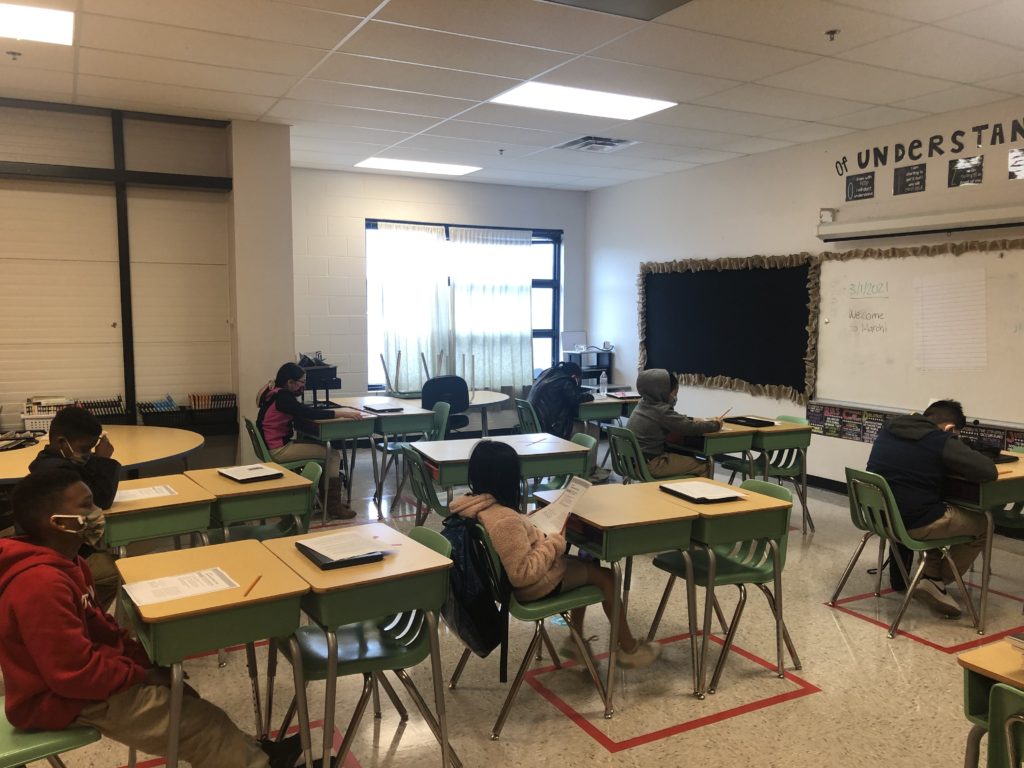
We started with a schedule of essentials students missed and needed.
Teachers are master planners. We routinely take a set of standards and end-of-year goals and miraculously construct a yearly plan that integrates everything our students need to know. It’s never easy, but it starts to become routine. I wanted to equivalate the opportunity to teach in-person again with what I’ve always done. I wanted to prepare a read-aloud, a writing block, close reading, guided reading, centers, and a language block for when I returned. The routine of teaching in-person sounded very comfortable, but it wasn’t what my students needed.
I chose to start slow. Here’s how my days go so far:
- We take a little bit longer than normal to eat breakfast. This ensures that we are following all safety protocols.
- Then we jump into a community meeting where we discuss what is going on with each of us emotionally and set our intentions for the day.
- Next, we move into a writing block. We write every day because the one thing virtual learning couldn’t replicate was the bond of taking pencil to paper.
- After writing, we work through a reading passage and break down some comprehension questions.
- We finish our reading block with a quick language practice.
- Additional time is spent diving into a good book or getting to collaborate on some partner work.
Our block, or what we do each day, will eventually grow, but for now, small steps are working just fine. Education isn’t about drilling knowledge, it’s creating learning opportunities big and small.
My grade-level teachers and I decided to partner to find new ways to personalize instruction.
I still have a lot of areas to get better at when it comes to being back in the physical classroom. We have students of all academic levels who opted to return in-person. You will always find me advocating for inclusive groups, but I know that I need to figure out how to better personalize and differentiate my instruction. I’m planning to partner with my teammates to create a shared grade level plan to accomplish this.
Returning to teach in the school building has left me with some throbbing feet and a full heart. I worry sometimes about what if one of my students contract COVID-19 or what if I somehow do and pass it on to them? I worry about this a lot. I’m also deeply concerned about what emotional toll that this year will have on my students for years to come. I certainly don’t have all the answers, and life is too beautiful to let us know the future. For now, my focus is reminding my students that they are safe at school, that they are loved, and that with time, things will get better.
Published on March 18, 2021
Read more stories about: Uncategorized.
Back In The Classroom
How This 5th Grade Teacher Brings Positive Role Models into his Classroom
Featuring Brandon LaBella, 5th Grade Teacher, Rocketship Spark Academy | March 1, 2023
In this 30-minute chat, you'll hear what keeps this teacher motivated, the power of relationships, and how he brought in speakers to discuss career paths and life perspectives.
Read more ⟩How to Spark Joy in ESL Classrooms with a Multilingual Learning Clubhouse
Featuring Ms. Amy De La Rosa, Multilingual Specialist, Nashville Northeast Elementary | June 1, 2023
Listen in to an audio interview with Amy De La Rosa, a Multilingual Specialist who has worked as an educator for over 14 years and found an innovative way to help her students learn English in a more accelerated, playful way.
Read more ⟩Supporting Parents of Multilingual Students in Family/Teacher Conferences
Emma Volpe, Rocketship United Academy | June 1, 2022
Get thoughtful insight on how to create a more inclusive family-teacher conference environment.
Read more ⟩5 Ways to Strengthen Relationships in the Classroom
James Cross, Assistant Principal, Rocketship Nashville Northeast Elementary | February 20, 2022
A new age of education calls for a new level of connection. Here are some key tips to strengthen relationships in your classroom this school year.
Read more ⟩How BurnIn Mental Strategies Can Improve an Educator's Experience
Rocketship Public Schools | February 21, 2022
Learn how teachers use BurnIn mindset strategies to focus on strengths, deepen relationships, and navigate challenging times.
Read more ⟩5 Ways School Leaders Can Coach and Support Teachers
Eesir Kaur, Director of Professional Development | October 15, 2020
Are you a school leader looking to coach your teachers more effectively? Here's what works for us.
Read more ⟩



